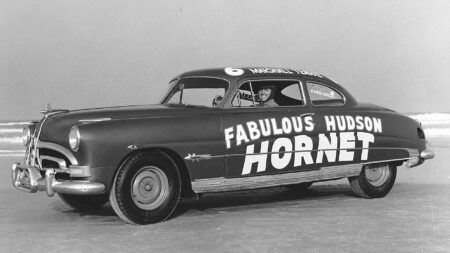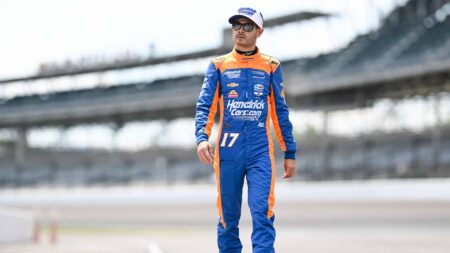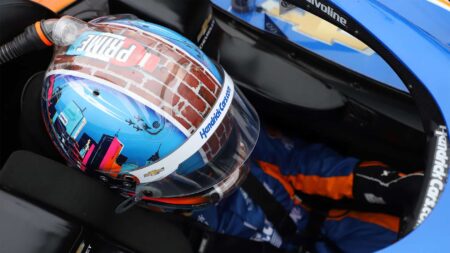
The real-life Hudson Hornet: story of a NASCAR icon
The massively successful Cars Disney film made Doc Hudson popular with fans young and old – James Elson tells the story behind the Hudson Hornet NASCAR it was based on
After Carl Edwards crashed into the fence at Talladega last month, with debris injuring seven spectators, the debate began about the state of safety on high-banked superspeedways. Edwards’ accident was ironic, of course, because it was at Talladega in 1987 where Bobby Allison crashed through the safety fence, tearing down a couple of hundred feet of fencing and causing minor injuries to some fans.

Allison’s accident ushered in the restrictor plate era at Talladega and Daytona, NASCAR’s biggest and fastest high-banked superspeedways. Starting in 1988 restrictor plates severely limited the volume of air a NASCAR engine could swallow through its carburettor, slashing horsepower almost in half. A current, unrestricted NASCAR Sprint Cup 5.8-litre V8 churns out almost 900 horsepower, but at Daytona and Talladega the gasping restrictor plate version makes barely 450bhp.

Bobby Allison
The result is that everyone drives around, pedal to the metal, in massive ‘drafting’ packs. The theory is any big accidents will be confined to the track and won’t spill over into the grandstands, and that theory has worked most of the time. But there have been exceptions, like Edwards’ Talladega tumble.

NASCAR discovered a convenient by-product of restrictor plate racing was that it made for furiously close races and often produced surprise winners. Daytona and Talladega became known for putting on tremendous, crowd-pleasing shows with plenty of made-for-TV action, spectacular multi-car accidents included.

Nor was it as if NASCAR didn’t promote the looming probability of ‘The Big One’ at both Daytona and Talladega. Wildly crashing stock cars were an integral part of NASCAR selling itself to the public and expanding into the wider popular culture, where it’s achieved so much success over the past 20 years as a corporate marketing tool.
It’s also important to realise that Bill France Sr built Daytona and Talladega with high banks to dramatically increase the speeds that stock cars could achieve. Forty and 50 years ago high speeds and new track records were the sport’s prime selling point. France understood that high-banked tracks would enable NASCAR stock cars to lap quicker than the speeds obtained by the much faster Indycars at the Indianapolis Motor Speedway, where the corners are inclined at only nine degrees, one-fourth as steep as those at Daytona and Talladega.
Conversely, Indycars soon discovered that high-banked tracks were too fast for them. After an experimental but deathly race in 1959 (see the March issue of Motor Sport) Indycars never returned to Daytona. Over the years Indycars have raced on many high-banked superspeedways like those at Michigan, Atlanta, Charlotte, Las Vegas, Texas and California, but fearsome speeds and some bad accidents (and a few spectator deaths too) discouraged the practice from continuing at most of these tracks.

Ovals with shallow banking like Indianapolis (above), Milwaukee, New Hampshire and Phoenix tend to be best for Indycars. The cornering speeds are slower and historically, at least, there were more possibilities for passing and side-by-side racing. But stock cars put on a better show on high-banked tracks and most drivers prefer banked ovals to flat tracks. So the two forms of racing are very much at cross purposes on ovals.
With today’s power-restricted, drag-laden Indycars struggling to put on much of a show or draw crowds to many of the IRL’s oval races, and quite a few of NASCAR’s unrestricted races renowned for too much follow-the-leader non-action, more than a few of the International Speedway Corporation and Bruton Smith’s 20-plus publicly-owned oval tracks are searching for answers to the riddle of how to promote strong events that are able to make a profit and stay in business. Without doubt, all aspects of the oval track balancing act are more difficult than ever in this day and age.

The massively successful Cars Disney film made Doc Hudson popular with fans young and old – James Elson tells the story behind the Hudson Hornet NASCAR it was based on

NASCAR star Kyle Larson is attempting 'The Double' this Sunday, driving the Indianapolis 500 and Coca-Cola 600 on the same day – but several factors could stand in his way

'The Double' is a challenge like no other in motor sport – we look at the brave racers who've taken on the Indianapolis 500 and Coca-Cola 600 on the same day

NASCAR has aimed big with its new Drive to Survive Netflix imitator Full Speed: can the docudrama match its lofty ambitions?